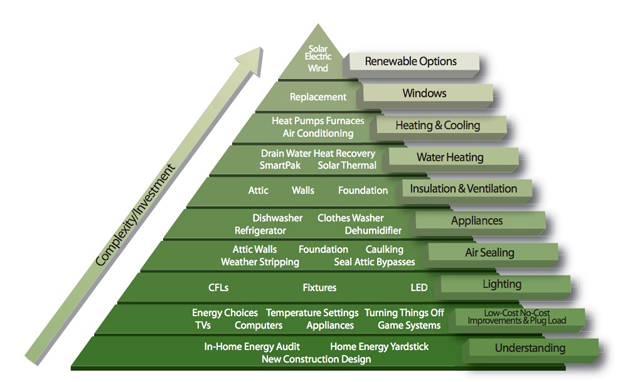So you want to improve the performance of your home?
And why wouldn’t you? From global warming to the Gulf oil spill, from dependence on foreign oil to the impact of energy costs on your wallet, there are lots of compelling reasons to conserve. And, given that buildings are responsible for at least 40% of carbon emissions in the US, our homes offer lots of room for improvement.
But where to begin?
This “Pyramid of Conservation” is a good place to start. Developed by Minnesota Power (and brought to our attention by a TreeHugger post), the pyramid organizes energy efficiency investments into layers ranging from the simplest, most cost-effective investments to the most complex and expensive.

The idea is to start at the bottom of the pyramid and to work your way up, building a solid foundation of energy efficiency along the way. Here are 3 secrets for home energy efficiency that the pyramid reveals:
- Knowledge Is Power
To reduce the carbon footprint of your house, start by assessing the situation and understanding the efficiency problems that need fixing. The home performance industry has grown to address this need, with its blower door tests, air duct diagnostics, computer modeling and other building science gadgets. It’s powerful stuff. A home performance assessment of your house will uncover all sorts of heretofore hidden causes of inefficiency, many of them quite inexpensive to address, along with a menu of remedies. And let’s not forget green building design. If done right, new homes and significant remodels draw on building science and design expertise to create highly efficient living spaces. Passive House and accessory dwelling unit designs are often exemplars in this regard. - It Might Not Be Sexy…
Non-sexy, non-flashy improvements make a big difference in increasing energy efficiency. Things like weather stripping, caulking, attic air sealing and insulation may not be inherently enticing to non-geeks, but they are cost effective. The result of focusing on the non-sexy? Lots of carbon saved per dollar spent. - Harvest Low-Lying Fruit Before Climbing Higher
Things like new high-efficiency windows or smartly-engineered heat pumps can save lots of energy, but are not the low-lying fruit for most homes. The pyramid suggests that to maximize energy efficiency gains you should fully address the lower, more cost-effective layers of conservation first. Don’t get me wrong. There are lots of good reasons to consider new windows (better sound insulation, added comfort, aesthetics and design, elimination of lead-painted frame and sills, and yes, energy efficiency). But on carbon-reduction grounds alone, lower layers of the pyramid should be examined first. Details vary from house to house, which is why a home performance assessment is important in determining the most cost-effective measures for your specific house.
-Zack
Back to Field Notes